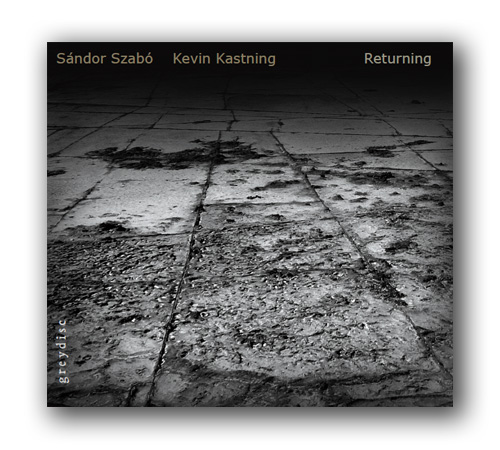


The recording of Returning by Sándor Szabó and
Kevin Kastning
The setting: Returning was recorded at Studio Traumwald in northern Massachusetts on July 5, 2008; a bright and clear New England summer day. The live room at Studio Traumwald consists of an 11-foot peaked ceiling, stone and barn wood asymmetrical walls, and thick carpeting. It makes for a beautiful sounding acoustical space. The studio's aural ambiance, and the element of the silence and stillness of the New England countryside makes for a wonderful and inspirational recording environment.
The technical: The recording process was very clean and direct; both figuratively and literally. Each of us was close-mic'ed, along with the addition of an Avant CK-40 stereo microphone in a mid-side configuration as a second mic for each of us. The microphones which were used are as follows.Microtech Gefell M-930 (my primary mic)
Avant CK-40 (my secondary mic: stereo M/S)Neumann TLM-103 (Sándor's primary mic)
Avant CK-40 (Sándor's secondary mic: stereo M/S)A purist approach was utilized at every step of the recording process. All microphones were routed through very pure microphone preamps: a Millennia HV-3D. These preamps were selected for their pristine, clean and uncolored amplification; as well as massive headroom and an exceedingly low noise floor. All studio cabling is either Gotham or Mogami Neglex. From the Millennia mic preamps, the lines were routed into a 24-bit/96k 16-track digital recorder. No EQ, compression or limiting was used; either in the live recordings or during mixdown. No compression or limiting may result in an overall volume level of the final CD which is somewhat lower than most other CDs. However, the beauty of not using compression is that the full and natural dynamic range of the original performance is captured. No equalization was used; either during the live recording or during the mixing or mastering. No studio tricks; no overdubs. What the listener hears on the CD is exactly how the compositions were performed in the recording studio. The only enhancement is the addition of Bricasti M7 digital reverb during the final mix.
The master tracks were mixed and mastered by Sándor at Tandem Records Experimental Studio in Vac, Hungary in late fall 2008.
From Studio Traumwald's lush but precise sounding live room, to the 24-bit/96k digital recording process to the final step of cutting the single-speed glass master, the end result is a very beautifully recorded, audiophile-grade CD.
Sándor's Notes on Returning
The Recording
"Recording with Kevin Kastning is not only a ritual of a spiritual communion, but also a recreation of the three-dimensional audible world. In other words, we create not only the music, but also the space where it can appear. This highly creative work starts with placing super high quality mics in the recording studio and when we captured many signals from the mics we choose which ones illustrate perfectly the nature of the guitars and supports best the music.
The Mix
The mix was done in my studio in Hungary. As always, I never use compression, EQ, or gimmicks; only the highest quality of reverb. Since the Bricasti M7 appeared I do not long for recording in real spaces, because real places sound well only by direct listening. After recording it, the magic of the three-dimensionality of the real spaces vanishes. The new reverb technology can give back this magic and it sounds even more three-dimensional and lively than the recorded real spaces. My concept was to use one main space, and for certain notes or parts of the music and instruments I used another size and type of space. This really expanded the sound and the music. By this concept, the music appears in a very precisely shaped dreamy soundscape and spacescape."
- Sándor Szabó,
Vác,Hungary
February 2009